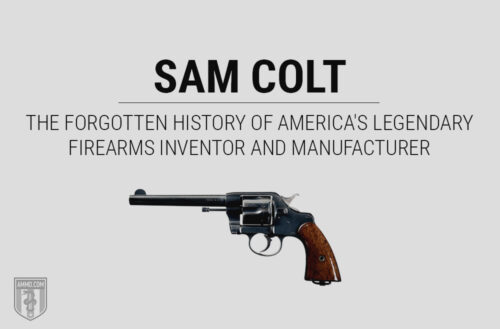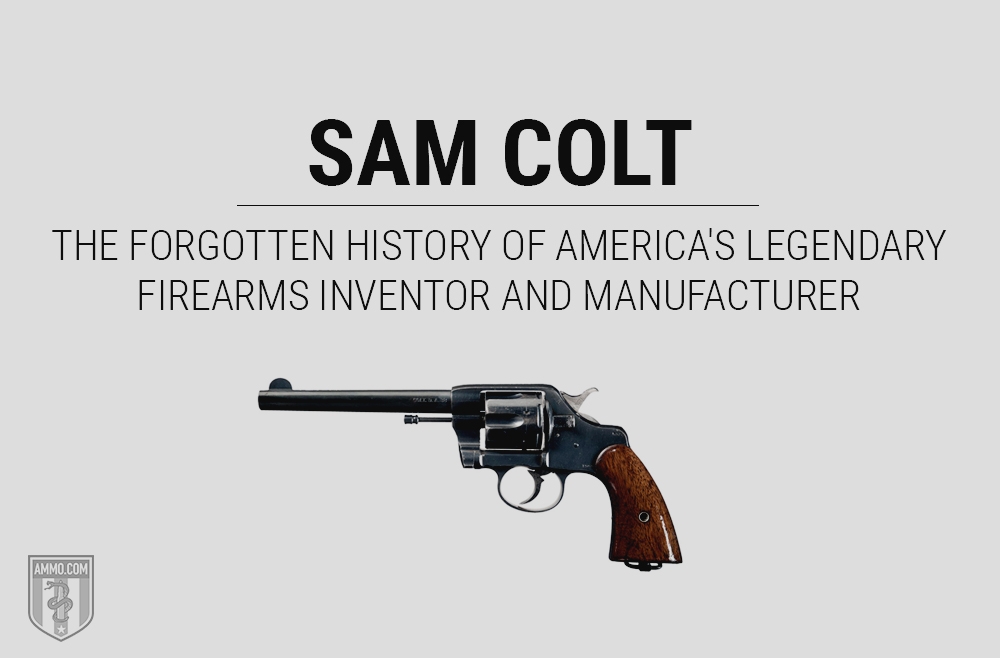
Born on July 19, 1814, in Hartford, Connecticut, Samuel Colt played a vital role in American culture and folklore. The inventor and creator of the first handheld revolver, Sam Colt made it possible to have a handgun that could fire rapidly without needing to be reloaded after every shot. Known as the great equalizer, it’s been said that “Abe Lincoln may have freed all men, but Sam Colt made them equal.”
Colt’s knack for inventing and his passion for firearms paved the way for the American fascination with guns. Some would argue that it’s because of Samuel Colt (and his shrewd business and advertising sense) that Colt became a household name, both during his lifetime and now, 200 years after his birth.

Sam Colt: From Tinkerer to Inventor
From the time he was a boy, Sam Colt liked to tinker with mechanics. He’d take things apart just to learn how they’d work. After studying the mechanics, he’d attempt to rebuild them. Sometimes it would work and sometimes it wouldn’t.
But young Sam had perseverance and he wasn’t one to be discouraged by a little failure, a trait that would suit him well throughout his life. Although his interest in mechanics was soon coupled with explosives, Sam joined his father’s textile company at 15, but he didn’t last long. After exploding a raft during a Fourth of July party, his father sent him away to boarding school, where Sam studied navigation.
During the following year, in 1830, Colt was expelled, again over a Fourth of July incident. This time, the young man demonstrated self-made explosives for his classmates, much to the dismay of the school’s administrators.
At his wit’s end, Sam’s father decided to give him a real lesson in navigation and sent him to become a seaman. It was this decision that led to the revolver and forever changed not only Sam’s life, but also the culture of America.
The Revolver: An Idea Discovered at Sea
It was while sailing to Calcutta that Colt was inspired by the ship’s wheel and began to design what would eventually become the world’s first rotation-style firearm. It intrigued him that no matter what direction the wheel moved, the spokes were aligned to the clutch in such a way that certain positions would allow the wheel to spin freely or lock it in place.
While still at sea, Sam carved a wooden prototype of his idea, which would allow a gun to house multiple bullets for firing, without risk of igniting them all at once.
Upon returning to the States in 1832, Sam petitioned his father, who sponsored the production of both a rifle and a pistol, each featuring Colt’s revolving chamber. Unfortunately, his father was not impressed with Sam’s design and refused to monetarily back either weapon.
But the 20-year-old Colt would not be discouraged. He spent the next two years travelling the country as “the Celebrated Dr. Coult of New York, London, and Calcutta,” entertaining and educating audiences about nitrous oxide and its effects. It was his profits from this tour that would build his next attempt at a pistol with a revolving chamber.
How Sam Colt Became a Gun Manufacturing Tycoon
In 1835, Samuel Colt received his first European patent for a revolving-chamber pistol. The following year, in 1836, he received one from the U.S. It was this same year, at the age of 22, that he built his first manufacturing plant in Paterson, New Jersey – Colt’s Patent Arms Manufacturing Company – which produced the Colt Paterson pistol. The original five-cylinder revolver came chambered in both .28 and .36 caliber, and had about as much power as a modern .380 ACP round.
The Paterson pistol allowed shooters to fire five shots in rapid succession. Before this revolutionary revolver, each shot required about 20 seconds to reload. Colt made an estimated 2,800 of these handguns and, although they were used in Florida during the Second Seminole War, the U.S. military decided the precision caps were too modern and untrustworthy for battle.
The Republic of Texas bought 180 of Colt’s new firearms to assist in arming the sovereign’s new Navy. When the surplus eventually fell to the hands of the Texas Rangers, they quickly came to appreciate the weapon’s efficiency and speed. During the Battle of Bandera Pass, where the Rangers were able to shoot 10 shots with two revolvers, the Colt Paterson had a significant influence in turning the tide of the Texas-Indian Wars.
Although these guns were showing their strength in the Old West with the Texas Rangers, many gun carriers were leary about the new firearm and preferred their trusted muskets. Without military support for Colt’s revolving gun, the company lost money and temporarily closed in 1842.
But Sam Colt wasn’t someone who gave up. And by 1845, word was getting around that front-line soldiers were seeing massive success with the innovative firearm and that these guns played critical roles in the victories that were starting to occur against the Native Americans.
With the dawning of the Mexican-American War in 1846, Colt was commissioned to arm the U.S. military. The Colt Manufacturing Company became the first private company to mass produce firearms, and from 1836 to 1861, they built an average of 1,000 guns a year. By 1865, Colt was the largest gun supplier to the Union Army, providing 386,417 revolvers throughout the Civil War.
Sam Colt: Shrewd Businessman and Marketing Genius
Sam Colt had a product he knew he could sell and in 1836, he started his first advertising campaign. He intentionally targeted America’s growing middle class, a group of people who suddenly had surplus time and funds. Following the British aristocrats, many of early America’s middle class turned to hunting for sport and Colt used that to his advantage, offering a gun that makes the process easier and much more effective.
Colt’s tactics went beyond strategic newspaper advertising and product placement. He ran ads depicting masculine men using Colt revolvers to protect their families. He commissioned artists to create paintings featuring Colt guns, putting them in exciting places and exotic territories.
And since few knew how to handle and care for firearms, he added simple instructions for gun maintenance on a provided cleaning cloth with every revolver, showing that all could learn to use a firearm and realize the benefits of gun ownership.
What’s more, Sam Colt was known to be extravagant, especially when it came to wining and dining. He’d treat top businessmen and members of Congress to dinner and drinks. He also gave lavish revolvers, often ornamented with engravings and gold, to military officials, European royalty, and Russian Czars. He even gave President Andrew Jackson a custom Colt handgun.
And then something happened – gun ownership in America began to grow. From 1830 through 1850 alone, wills mentioning gun ownership rose 50 percent. And in 1855, Sam Colt had incorporated offices in Hartford, New York City, and London, and was producing 150 guns a day. By the dawning of the Civil War, his Connecticut plant employed over 1,000 people. By the time of his death on January 10, 1862, at the age of 47, it’s estimated that the Colt company had produced over 400,000 firearms.
Sam Colt: The Legend and His Legacy
Sam Colt’s name is attached to many of America’s most iconic revolvers, partially because he held a manufacturing monopoly on them for decades. Perhaps the most revered of firearms designed and manufactured by Colt himself, is the 1873 Peacemaker, coined the most popular gun in the West.
Then there are the other esteemed firearms manufactured by the Colt company, including:
- Colt Model 1860 Army Revolver in .44 caliber
- Colt Gatling Gun, which fired .45-70 Government cartridges at a rate of 800 to 1,000 rounds per minute
- Colt 1873 Single Action Army Revolver, which throughout its history was chambered in:
- Colt 1911 chambered in .45 ACP
Sam Colt changed the firearm industry almost more than any other individual, but he did more than that. As an inventor, his creations weren’t limited to gunpower and steel. Colt is responsible for leading America in the interchangeable parts system of manufacturing. He built the first remote naval mine explosive, and created the waterproof cables that allowed Samuel Morse to run telegraph lines beneath the sea.
At his death at the age of 47, Sam left behind his wife, Elizabeth Jarvis, who he married five years beforehand in 1856. Of their five children, only Caldwell Hart Colt survived past infancy. His wife and son were left well taken care of with their mansion, Armsmear, and an estate worth $15 million, which is estimated to be around $350 million today. Even more astounding, the value of Colt’s estate was, at the time, 1/1,000 of the country’s total GNP. Today, that makes his fortune equivalent to about $17 billion.
A Farewell to Be Remembered
When the man whose name became synonymous with revolver (the French word for revolver is Le Colt) died, the town of Hartford, Connecticut, mourned for their loss and celebrated his life. It’s said that Colt’s funeral rivaled the last act of a great opera. Fifteen hundred of his employees showed up to show their final respect, each with a black band tied around their arms.
Sam’s casket was visited by Company A, 12th Regiment, Connecticut Volunteers, a guard that he had personally armed. They were followed by the Putnam Phalanx, the Connecticut honor guard, and then thousands of people from Hartford watched as Colt’s remains were carried to a private graveyard on his estate.
In 1894, when Colt’s only surviving child died, Elizabeth had Sam’s body, along with the remains of their other four children, moved to Cedar Hill Cemetery. Today, the public can visit Sam’s grave, along with the rest of the Colt family.
“Sam Colt: The Forgotten History of America’s Legendary Firearms Inventor and Manufacturer” originally appeared in The Resistance Library at Ammo.com, written by Molly Carter.
